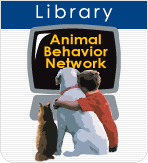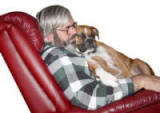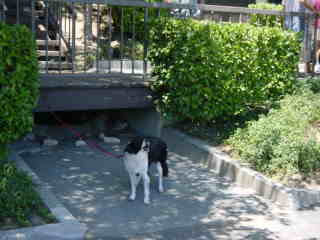|
Need Help?
|
|
Call
1-800-372-3706
to
speak to a Veterinary Behavior Technician |
|
Paws To Speak!
Member
Main Menu
|

Easy Library Link
Separation
Anxiety

Veterinary
Tip Practice
Give the dog something to
do. Ask the client NOT to feed the dog the
morning they come into the practice. Ask the client
for permission to use sedation if all other efforts
fail to comfort the dog during the owner's absence.

At Home
Provide
non-consumable chews and food puzzles to give the
dog something to do and think when left alone.
|
 |
|
Help is at your
fingertips by library, email and
phone. |

Click on
Library Icon
to learn more
|
 What is separation
anxiety? What is separation
anxiety?
Separation
anxiety is a behavioral problem in dogs who are so
bonded to a person or dog companion that, if
separated, they exhibit a high degree of anxiety or
excessive distress. These dogs have been nicknamed,
"velcro dogs" because they stick so close to their
owners, often preferring to lean on them.
Separation anxiety is
thought to be an extreme of the social nature of
dogs and what's considered normal attachment to
others.
The most commonly exhibited behaviors
associated with separation anxiety dogs are
inappropriate elimination, household destruction,
and excessive vocalization (barking and/or whining).
Other visible signs
are digging, hiding, trembling, salivating,
panting, excessive licking, and even vomiting or
diarrhea, may occur.
Separation anxiety symptoms
only occur when the dog is separated from his or her
person. This includes "virtual
separation" where the person is home but the dog
cannot see or gain access to the person.
|
Certain dogs are genetically
more prone to separation
anxiety than others. |
Separation anxiety
may suddenly appear in older dogs and may be
associated with anticipatory anxiety.
Dogs who have
had their basic attachment to their previous owner
broken through a surrender situation or death can
develop separation anxiety.
Signs of separation
anxiety are commonly reported in studies of guide
dogs.
A common history in dogs with separation
anxiety includes a previous bond to an owner and
then the person, for whatever reason, is taken away
from the dog. For this reason, dogs who are adopted
from animal shelters are prone to develop separation
anxiety.
|
To prevent separation
anxiety it is important that
the dog have frequent, fun,
relaxed time away from the
owner and leader. |
Making separation fun
Provide a favorite "food puzzle"
toy prior to leaving home, as
well as at other times during
the day (so that the dog does
not associate the toy as a
departure cue). Food puzzles are
chew toys that contain food
inside them (e.g., Kong®, Buster
Cube®, Xtreme Goodie Toy®,
etc.). It's a puzzle for the dog
to figure out how to get the
food out of the toy. The goal is
to get the dog's mind on
something stimulating and fun
while his or her people are
away.
Sending the dog
to
doggie
daycare
where he or she can be away from
the owner for periods of time in
a supervised situation, and
having fun, is also recommended.
If no daycare is available, look
for some other location (e.g., a
friend's house) where the dog
can have a positive experience
away from the owner, to help
prevent separation anxiety.
Calm arrivals and departures
Decrease the emotional intensity
of greetings and departures to
also help prevent separation anxiety. Most people
enjoy coming home to a wildly
enthusiastic
canine greeting. Similarly, many
people give their beloved dog an
emotional good-bye. These
emotional swings related to
coming and going are often a
part of the problem.
separation anxiety. Most people
enjoy coming home to a wildly
enthusiastic
canine greeting. Similarly, many
people give their beloved dog an
emotional good-bye. These
emotional swings related to
coming and going are often a
part of the problem.
Make your
good-byes brief and "no big
deal."
Delay greetings until the dog is
calm enough to "sit" on Instruction, and
then give the dog the attention he
or she so richly deserves.
Gradual schedule changes
Sudden, major changes in a pet's
life can cause anxiety. If there
will be a major change in an
owner's schedule or the amount
of time the owner will be able
to spend with the dog, some
thought should be given to
making the changeover as gradual
as possible. The dog will
greatly benefit from
preparation.
Seeking additional help
Other signs of stress may be
misinterpreted as separation
anxiety. Dogs exhibit a great
deal of stress due to lack of
exercise and mental stimulation.
If your dog gets daily exercise,
companionship and clear
leadership from the humans in
the household and severe stress
is still exhibited, then your
dog may be showing signs of
separation anxiety or a medical
problem. Contact your
veterinarian to assist with
proper diagnosis and treatment
plan.
|